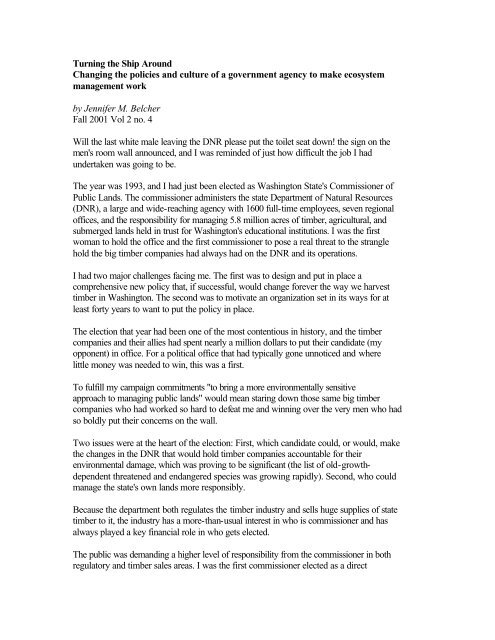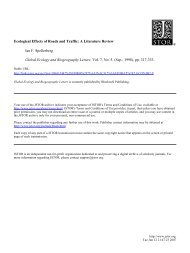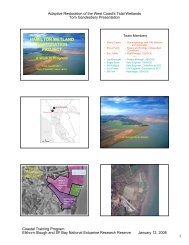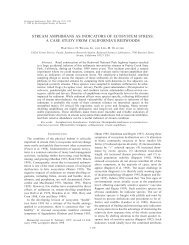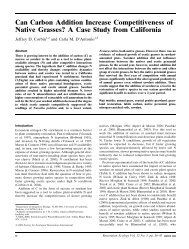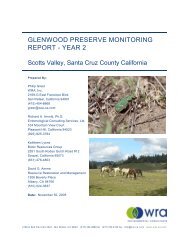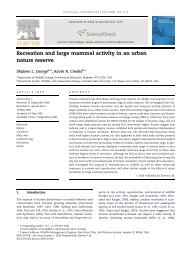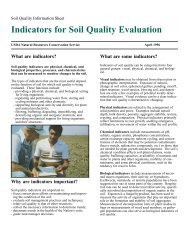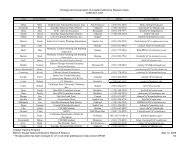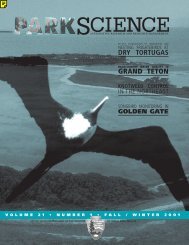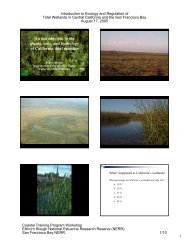Turning the Ship Around Changing the policies and culture of a ...
Turning the Ship Around Changing the policies and culture of a ...
Turning the Ship Around Changing the policies and culture of a ...
You also want an ePaper? Increase the reach of your titles
YUMPU automatically turns print PDFs into web optimized ePapers that Google loves.
<strong>Turning</strong> <strong>the</strong> <strong>Ship</strong> <strong>Around</strong><br />
<strong>Changing</strong> <strong>the</strong> <strong>policies</strong> <strong>and</strong> <strong>culture</strong> <strong>of</strong> a government agency to make ecosystem<br />
management work<br />
by Jennifer M. Belcher<br />
Fall 2001 Vol 2 no. 4<br />
Will <strong>the</strong> last white male leaving <strong>the</strong> DNR please put <strong>the</strong> toilet seat down! <strong>the</strong> sign on <strong>the</strong><br />
men's room wall announced, <strong>and</strong> I was reminded <strong>of</strong> just how difficult <strong>the</strong> job I had<br />
undertaken was going to be.<br />
The year was 1993, <strong>and</strong> I had just been elected as Washington State's Commissioner <strong>of</strong><br />
Public L<strong>and</strong>s. The commissioner administers <strong>the</strong> state Department <strong>of</strong> Natural Resources<br />
(DNR), a large <strong>and</strong> wide-reaching agency with 1600 full-time employees, seven regional<br />
<strong>of</strong>fices, <strong>and</strong> <strong>the</strong> responsibility for managing 5.8 million acres <strong>of</strong> timber, agricultural, <strong>and</strong><br />
submerged l<strong>and</strong>s held in trust for Washington's educational institutions. I was <strong>the</strong> first<br />
woman to hold <strong>the</strong> <strong>of</strong>fice <strong>and</strong> <strong>the</strong> first commissioner to pose a real threat to <strong>the</strong> strangle<br />
hold <strong>the</strong> big timber companies had always had on <strong>the</strong> DNR <strong>and</strong> its operations.<br />
I had two major challenges facing me. The first was to design <strong>and</strong> put in place a<br />
comprehensive new policy that, if successful, would change forever <strong>the</strong> way we harvest<br />
timber in Washington. The second was to motivate an organization set in its ways for at<br />
least forty years to want to put <strong>the</strong> policy in place.<br />
The election that year had been one <strong>of</strong> <strong>the</strong> most contentious in history, <strong>and</strong> <strong>the</strong> timber<br />
companies <strong>and</strong> <strong>the</strong>ir allies had spent nearly a million dollars to put <strong>the</strong>ir c<strong>and</strong>idate (my<br />
opponent) in <strong>of</strong>fice. For a political <strong>of</strong>fice that had typically gone unnoticed <strong>and</strong> where<br />
little money was needed to win, this was a first.<br />
To fulfill my campaign commitments "to bring a more environmentally sensitive<br />
approach to managing public l<strong>and</strong>s" would mean staring down those same big timber<br />
companies who had worked so hard to defeat me <strong>and</strong> winning over <strong>the</strong> very men who had<br />
so boldly put <strong>the</strong>ir concerns on <strong>the</strong> wall.<br />
Two issues were at <strong>the</strong> heart <strong>of</strong> <strong>the</strong> election: First, which c<strong>and</strong>idate could, or would, make<br />
<strong>the</strong> changes in <strong>the</strong> DNR that would hold timber companies accountable for <strong>the</strong>ir<br />
environmental damage, which was proving to be significant (<strong>the</strong> list <strong>of</strong> old-growthdependent<br />
threatened <strong>and</strong> endangered species was growing rapidly). Second, who could<br />
manage <strong>the</strong> state's own l<strong>and</strong>s more responsibly.<br />
Because <strong>the</strong> department both regulates <strong>the</strong> timber industry <strong>and</strong> sells huge supplies <strong>of</strong> state<br />
timber to it, <strong>the</strong> industry has a more-than-usual interest in who is commissioner <strong>and</strong> has<br />
always played a key financial role in who gets elected.<br />
The public was dem<strong>and</strong>ing a higher level <strong>of</strong> responsibility from <strong>the</strong> commissioner in both<br />
regulatory <strong>and</strong> timber sales areas. I was <strong>the</strong> first commissioner elected as a direct
esponse to <strong>the</strong> desire for greater environmental protection.<br />
<strong>Changing</strong> Public Policy<br />
There are two things you should never watch-making sausage <strong>and</strong> making <strong>the</strong> law. I'm<br />
going to add making public policy. Today's expectations <strong>of</strong> public policy makers are<br />
almost impossible to meet. And to go into well-established bureaucracies <strong>and</strong> make<br />
meaningful change is extraordinarily difficult.<br />
For purposes <strong>of</strong> this article, I'm going to use only one example <strong>of</strong> my attempts to make<br />
policy change, but it is one that probably represents <strong>the</strong> most incredible change we were<br />
able to make. It certainly will illustrate <strong>the</strong> necessity <strong>and</strong> difficulty <strong>of</strong> changing an<br />
organization's <strong>culture</strong>. To change public policy, I had to overcome <strong>the</strong> resistance <strong>of</strong> <strong>the</strong><br />
timber companies (who were fearful <strong>of</strong> new regulatory requirements), as well as bring to<br />
<strong>the</strong> department a new way <strong>of</strong> doing business. This meant changing <strong>the</strong> long established<br />
<strong>culture</strong> <strong>of</strong> <strong>the</strong> DNR.<br />
At this point, I must be honest <strong>and</strong> tell you that I'm not sure it's possible to truly change<br />
<strong>the</strong> <strong>culture</strong> <strong>of</strong> a department (or business), but that is clearly what <strong>the</strong> men's room signs<br />
indicated my new employees were fearful <strong>of</strong>. They were convinced that having a woman,<br />
<strong>and</strong> especially a woman who was not a forester <strong>and</strong> who presumably didn't underst<strong>and</strong><br />
<strong>the</strong> timber industry, meant that <strong>the</strong>ir lives were going to change in ways <strong>the</strong>y didn't like.<br />
My first <strong>and</strong> most important task was to gain <strong>the</strong> confidence <strong>of</strong> my employees. They<br />
were, after all, <strong>the</strong> people who would ei<strong>the</strong>r carry out my <strong>policies</strong> <strong>and</strong> philosophies or<br />
trash <strong>the</strong>m. So I set out to meet all <strong>the</strong> employees <strong>of</strong> <strong>the</strong> department in my first two<br />
weeks-no easy task, I assure you. The "department" is spread over <strong>the</strong> entire state <strong>of</strong><br />
Washington, with employees living in 200 communities. But we managed to pull <strong>the</strong>m<br />
toge<strong>the</strong>r in <strong>the</strong>ir regions, or at <strong>the</strong> headquarters building in Olympia, so that I could<br />
introduce myself, lay out <strong>the</strong> plans that I had, <strong>and</strong> ask for <strong>the</strong>ir help <strong>and</strong> advice. A<br />
significant majority <strong>of</strong> <strong>the</strong>m were eager to help <strong>and</strong> were pleased to be asked. I can<br />
remember one long-time employee who put it this way: "Just tell me how many trees per<br />
acre you want left, <strong>and</strong> we'll do it!"<br />
But <strong>the</strong> changes we needed to make were far more complex than that approach would<br />
have allowed. We were attempting to introduce an "ecosystem" approach, which meant<br />
that we needed to consider <strong>the</strong> full impacts <strong>of</strong> our timber harvest activities on <strong>the</strong> entire<br />
ecosystem. Our task, simply stated, was to find ways to harvest $300 million worth <strong>of</strong><br />
timber each year <strong>and</strong> still leave good habitat for fish <strong>and</strong> wildlife <strong>and</strong> great places for<br />
people to recreate. And to do it over 1.8 million acres <strong>of</strong> l<strong>and</strong>.<br />
In 1993, most <strong>of</strong> <strong>the</strong> private timber companies were actively working to overturn <strong>the</strong><br />
Endangered Species Act (ESA) in Congress. I believed that to be a foolhardy <strong>and</strong><br />
impossible goal <strong>and</strong> so looked for alternatives. Ultimately, we opted to develop what's<br />
called a "Habitat Conservation Plan" (HCP).
At <strong>the</strong> time, no o<strong>the</strong>r large l<strong>and</strong>owner had undertaken such an extensive activity. There<br />
was a lot <strong>of</strong> skepticism, both in <strong>the</strong> department <strong>and</strong> in <strong>the</strong> industry, about what it would<br />
cost to develop such a plan, <strong>and</strong> whe<strong>the</strong>r <strong>the</strong> U.S. Fish <strong>and</strong> Wildlife Service <strong>and</strong> <strong>the</strong><br />
National Marine Fisheries Service would actually ever approve it. I felt <strong>the</strong> state had little<br />
choice. Unlike <strong>the</strong> private companies, each <strong>of</strong> our timber sales was publicly advertised<br />
<strong>and</strong> highly scrutinized. There was growing scientific evidence that large-scale clearcuts<br />
were damaging water quality <strong>and</strong> helping to bring specific animals near extinction. The<br />
nor<strong>the</strong>rn spotted owl <strong>and</strong> <strong>the</strong> marbled murrelet had just been listed as threatened, <strong>and</strong><br />
<strong>the</strong>re was considerable discussion <strong>of</strong> <strong>the</strong> coming listings <strong>of</strong> salmon <strong>and</strong> steelhead. And<br />
<strong>the</strong> state's 2.1 million acres <strong>of</strong> forestl<strong>and</strong>s contained much <strong>of</strong> <strong>the</strong>se species' remaining<br />
habitat.<br />
So, we set out to develop <strong>the</strong> HCP. We gave ourselves eighteen months to gain approval,<br />
which proved to be about half <strong>the</strong> actual time necessary. The HCP was approved by <strong>the</strong><br />
department's governing board <strong>and</strong> <strong>the</strong> federal government in January, 1997. At that time,<br />
we had developed <strong>the</strong> largest multi-species protection plan in <strong>the</strong> country, covering 1.8<br />
million acres <strong>of</strong> l<strong>and</strong>.<br />
From <strong>the</strong> very first discussion <strong>of</strong> our HCP, we included our attorneys in <strong>the</strong> process. They<br />
helped us to formulate assumptions, review scientific decisions, draft communications<br />
materials, <strong>and</strong> negotiate with <strong>the</strong> approving bodies; <strong>and</strong> <strong>the</strong>y defended us, successfully, I<br />
might add, in court. Whenever you make significant change in public policy today you<br />
should expect to be sued. Unfortunately, this has become a st<strong>and</strong>ard step in <strong>the</strong> process,<br />
almost as certain as public information requests <strong>and</strong> environmental impact analysis, <strong>and</strong>,<br />
yes! <strong>the</strong>re it is-step number X-go to court. Anticipating a lawsuit can help you win your<br />
case. We were sued by some <strong>of</strong> <strong>the</strong> trust beneficiaries, who believed <strong>the</strong>ir revenue from<br />
timber sales would be affected, <strong>and</strong> ultimately settled <strong>the</strong> case in our favor. The state is<br />
still threatened with litigation by <strong>the</strong> Native American tribes, who believe <strong>the</strong> plan does<br />
not <strong>of</strong>fer strong enough environmental protections.<br />
What we had achieved to this point was monumental: we had changed <strong>the</strong> <strong>policies</strong> that<br />
govern <strong>the</strong> management <strong>of</strong> state-owned l<strong>and</strong>s in Washington. And <strong>the</strong>re were important<br />
lessons learned in <strong>the</strong> process. Whe<strong>the</strong>r you are setting out to change <strong>the</strong> <strong>policies</strong> <strong>of</strong> a<br />
public agency or a private company, you are changing many <strong>culture</strong>s: <strong>the</strong> <strong>culture</strong> <strong>of</strong><br />
decision making, <strong>the</strong> <strong>culture</strong> <strong>of</strong> employee behavior, <strong>and</strong> <strong>the</strong> <strong>culture</strong> <strong>of</strong> public acceptance.<br />
All must be attended to if you want <strong>the</strong> change to be successful.<br />
The cultural changes we had achieved to this point were mostly related to changing<br />
public perception <strong>of</strong> what is or is not acceptable practice for a government agency<br />
managing public l<strong>and</strong>s. The critical elements <strong>of</strong> our success included:<br />
- A well-developed strategy to gain approval <strong>of</strong> our HCP by <strong>the</strong> public, <strong>the</strong> governing<br />
board, our beneficiary groups, <strong>the</strong> Governor, <strong>and</strong> ultimately <strong>the</strong> state legislature<br />
- Assurance <strong>of</strong> a scientifically credible basis for <strong>the</strong> provisions <strong>of</strong> <strong>the</strong> plan<br />
- Good legal advice <strong>and</strong> support<br />
- A keen underst<strong>and</strong>ing <strong>of</strong> our adversaries
- Media support<br />
- Convincing <strong>the</strong> majority <strong>of</strong> our employees that this was <strong>the</strong> right thing to do<br />
We now had before us a very thick plan that our employees would put into practice on<br />
<strong>the</strong> ground <strong>and</strong> in <strong>the</strong> field. It was time to tackle <strong>the</strong> <strong>culture</strong> <strong>of</strong> employee behavior.<br />
Making <strong>the</strong> Change Real<br />
I have been reminded many times that change is great-so long as it's <strong>the</strong> o<strong>the</strong>r guy you're<br />
asking to do <strong>the</strong> changing! Employees, even those truly ready to learn new ways <strong>of</strong><br />
working, needed a lot more information about <strong>the</strong> coming changes than we were <strong>of</strong>ten<br />
able to give <strong>the</strong>m. Even though we set up employee committees, put <strong>the</strong>m in charge <strong>of</strong><br />
scientific <strong>and</strong> technical work groups, <strong>and</strong> included personal contact with me on a regular<br />
basis, it was never enough to overcome <strong>the</strong> natural concerns that employees had about<br />
<strong>the</strong>ir job changing.<br />
It goes almost without saying that in order to change a <strong>culture</strong> you first have to<br />
underst<strong>and</strong> it, <strong>and</strong> you need to keep clearly in mind <strong>the</strong> results you want to achieve.<br />
The department had a well-established <strong>culture</strong> when I arrived in 1993:<br />
- It was almost exclusively white.<br />
- It was mostly male, with females primarily in clerical, employee services, accounting,<br />
<strong>and</strong> some information technology jobs.<br />
- It was steeped in forty years <strong>of</strong> traditional forestry (knowledge was h<strong>and</strong>ed down from<br />
old forester to new).<br />
- Employees believed that you should begin <strong>and</strong> end your thirty-year state government<br />
career in <strong>the</strong> department.<br />
- There was an apparent "right <strong>of</strong> promotion" based almost totally on seniority.<br />
- The timeframe for change was thought to be <strong>the</strong> same as that <strong>of</strong> a timber rotation-sixty<br />
years from start to finish.<br />
- Employees saw <strong>the</strong>mselves as <strong>the</strong> "good guys," protecting <strong>the</strong> state's trust l<strong>and</strong>s,<br />
sometimes even against <strong>the</strong> public who own <strong>the</strong> trusts.<br />
The <strong>culture</strong> I needed to have in place if we were to succeed in implementing <strong>the</strong> new<br />
<strong>policies</strong> included:<br />
- An ability to take decisive action, quickly reaching all 1600 employees<br />
- Willingness to incorporate scientific findings about <strong>the</strong> needs <strong>of</strong> fish <strong>and</strong> wildlife<br />
- A more truthful recognition <strong>of</strong> <strong>the</strong> impacts <strong>of</strong> timber harvest on <strong>the</strong> environment<br />
- Flexibility in our approach to doing our jobs<br />
- Valuing <strong>the</strong> new <strong>and</strong> questioning <strong>the</strong> old<br />
- Responsiveness to public perception <strong>and</strong> political reality<br />
- Diversity to match our growing population<br />
To achieve <strong>the</strong> new <strong>culture</strong>, I knew we'd have to bring in some new people, convince
current employees that <strong>the</strong> new ways were beneficial to <strong>the</strong>m <strong>and</strong> <strong>the</strong> department, <strong>and</strong><br />
develop <strong>and</strong> maintain an incredible communication system to continually reach 1600<br />
people.<br />
Finding "In House Cheerleaders"<br />
I got some really good advice from an old friend who said, "If you want to change a<br />
department as big as DNR, you can't do it from <strong>the</strong> top. You've got to have people at<br />
every level <strong>of</strong> <strong>the</strong> organization who are not only on your team but are your cheerleaders.<br />
If you can't find <strong>the</strong>m in <strong>the</strong> organization, <strong>the</strong>n get control <strong>of</strong> hiring <strong>and</strong> make sure you<br />
bring <strong>the</strong>m in at every level."<br />
Although <strong>the</strong> existing civil service system in Washington doesn't allow an agency<br />
director to "get control" <strong>of</strong> <strong>the</strong> hiring at every level, I was able to influence hiring<br />
decisions by being very specific about <strong>the</strong> effect that hiring good employees would have<br />
on a supervisor's evaluation for advancement.<br />
Ultimately, I went looking for specific individuals at each level <strong>of</strong> <strong>the</strong> department who<br />
would become <strong>the</strong> "in-house cheerleaders" for our proposed changes. In some instances<br />
that meant hiring new people, <strong>and</strong> in most it simply meant finding <strong>the</strong> employee who was<br />
willing to take a risk with his fellow workers, was curious about what we were doing, or<br />
simply was <strong>the</strong> recognized "leader <strong>of</strong> <strong>the</strong> gang," <strong>and</strong> converting him to our plan. In a<br />
small number <strong>of</strong> cases, I had to remove a person who was determined to go in ano<strong>the</strong>r<br />
direction.<br />
To recruit <strong>the</strong>se cheerleaders, we worked hard to make sure all employees understood<br />
how valuable <strong>the</strong>y were to <strong>the</strong> department <strong>and</strong> to our plans. We surveyed all employees<br />
<strong>and</strong> asked for <strong>the</strong>ir advice on key topics, <strong>and</strong> we established an employee advisory<br />
committee to work directly with executive management. Two actions that paid real<br />
dividends were <strong>the</strong>se:<br />
First, we ensured that <strong>the</strong> science group was led by scientists in <strong>the</strong> department. Both<br />
Chuck Turley <strong>and</strong> Lenny Young were highly regarded inside <strong>and</strong> outside <strong>the</strong> DNR. Their<br />
ability to discuss science in lay terms <strong>and</strong> to translate <strong>the</strong> scientific impacts <strong>of</strong> each policy<br />
option was absolutely <strong>the</strong> most important aspect <strong>of</strong> our entire plan. We were fortunate to<br />
have in our department two people with <strong>the</strong>se skills, <strong>and</strong> <strong>the</strong>y became our most important<br />
weapon in <strong>the</strong> science vs. politics battle. As scientists, <strong>the</strong>y had credibility everywherewith<br />
o<strong>the</strong>r scientists, with our employees, with policy makers, with our governing board,<br />
<strong>and</strong> with our adversaries. Because both were exceptionally skilled communicators, <strong>the</strong>y<br />
were able to translate <strong>the</strong>ir considerable knowledge into on-<strong>the</strong>-ground impacts <strong>of</strong> each<br />
choice, thus allowing <strong>the</strong> policy makers to know <strong>the</strong> ultimate results <strong>of</strong> <strong>the</strong> choices <strong>the</strong>y<br />
would make.<br />
Second, we placed a long-time employee <strong>of</strong> <strong>the</strong> department-one who had been part <strong>of</strong> <strong>the</strong><br />
"old ways" <strong>of</strong> doing things-in charge <strong>of</strong> plan development. We needed someone who<br />
understood how things had been done, <strong>and</strong> why, if we were to do <strong>the</strong>m differently. We
also needed someone with operational knowledge <strong>of</strong> <strong>the</strong> department so that when our<br />
scientists proposed things that wouldn't work or would be time consuming <strong>and</strong> costly, we<br />
would know immediately. Selecting Rick Cooper to be in charge <strong>of</strong> <strong>the</strong> project gave us<br />
credibility with almost all <strong>the</strong> employees <strong>of</strong> <strong>the</strong> department. When <strong>the</strong> few employees<br />
who simply would never go along with change came forward to protest, having <strong>the</strong>m<br />
argue with <strong>the</strong> "pr<strong>of</strong>essional forestry manager" with twenty-five years <strong>of</strong> department<br />
experience, ra<strong>the</strong>r than with me, assured our success.<br />
Training <strong>and</strong> Repetition<br />
I have always known that training is crucial. What I didn't know was just how difficult it<br />
can be to get it to take!<br />
Our first training program was a week long, <strong>and</strong> every forester in <strong>the</strong> department (several<br />
hundred people) participated. We repeated key portions several months later, we printed<br />
<strong>the</strong>m up <strong>and</strong> gave everybody copies, we had <strong>the</strong> key thoughts put on walls all over <strong>the</strong><br />
department, we used <strong>the</strong>m as <strong>the</strong> basis for fun "tests" <strong>and</strong> games at staff meetings. But<br />
what we ran headlong into was human nature, which is to find what's comfortable <strong>and</strong><br />
stay <strong>the</strong>re until you're forced to move.<br />
Sometimes our employees would take <strong>the</strong> new ideas into <strong>the</strong> field, try to put <strong>the</strong>m in<br />
place, <strong>and</strong> when it was too difficult, simply revert back to what <strong>the</strong>y knew. In o<strong>the</strong>r cases,<br />
<strong>the</strong>y were unwilling to tell us that <strong>the</strong> new ideas didn't make sense to <strong>the</strong>m or that <strong>the</strong>y<br />
simply didn't underst<strong>and</strong>. And it would <strong>the</strong>n be months before we would discover that <strong>the</strong><br />
new practices weren't being followed.<br />
Recognizing that we needed someone who was "one <strong>of</strong> <strong>the</strong>m"-a department forester-to<br />
devote time in <strong>the</strong> field to helping people make <strong>the</strong> change, we selected Michael Perez-<br />
Gibson, a twenty-year veteran <strong>of</strong> <strong>the</strong> department, who was respected by his colleagues.<br />
Michael has a curious mind <strong>and</strong> was absolutely dedicated to making <strong>the</strong> HCP work. At<br />
<strong>the</strong> time, Michael was manager <strong>of</strong> our entire forestry program <strong>and</strong> had <strong>the</strong> authority to<br />
direct field operations to meet our new policy. We sent him to <strong>the</strong> field to talk with<br />
foresters, to challenge <strong>the</strong>m, to make <strong>the</strong>m remember<strong>the</strong>ir early days in <strong>the</strong> department<br />
when everything <strong>the</strong>y did was new <strong>and</strong> foreign, <strong>and</strong> to remind <strong>the</strong>m <strong>of</strong> <strong>the</strong>ir resilience <strong>and</strong><br />
<strong>the</strong>ir past succeses. In o<strong>the</strong>r words, to help <strong>the</strong>m cross over into <strong>the</strong> new world <strong>of</strong> 21st<br />
century forestry.<br />
Michael realized that ano<strong>the</strong>r very special training program was needed, <strong>and</strong> we hired<br />
two pr<strong>of</strong>essionals from <strong>the</strong> University <strong>of</strong> Washington, Pr<strong>of</strong>essors Jerry Franklin <strong>and</strong><br />
Andrew Carey, to develop a training program for teh twenty people out <strong>of</strong> 1600 who<br />
were in key supervisory positions in those regions where we needed to make <strong>the</strong> most<br />
change quickly. This would be a real test <strong>of</strong> out ability to change thinking in <strong>the</strong><br />
department because <strong>the</strong> two pr<strong>of</strong>essors, especially Jerry, were seen as "radical" thinkers<br />
<strong>and</strong> environmental sympathizers. I will never forget that program because it market teh<br />
turning point in successful implementation <strong>of</strong> our plan.
The training was held at a forest service site in <strong>the</strong> foothills <strong>of</strong> <strong>the</strong> Cascade Mountains,<br />
about an hour <strong>and</strong> a half from our headquarters in Olympia. I had driven <strong>the</strong>re to kick <strong>of</strong>f<br />
<strong>the</strong> training <strong>and</strong> for what felt like <strong>the</strong> millionth time in five years, stared down some <strong>of</strong><br />
teh old guard in <strong>the</strong> department. There were people over whom I had little control sine<br />
<strong>the</strong>y were civil service employees who would most likely be <strong>the</strong>re when my terms as<br />
commissioner were over, in fact <strong>the</strong>y didn't hesitate to remind me on a regular basis.<br />
That evening, a number <strong>of</strong> our trainees literally had arms folded across <strong>the</strong>ir chests,<br />
learned back in <strong>the</strong>ir chairs, <strong>and</strong> issued a oh-so-obvious challenge to me <strong>and</strong> <strong>the</strong>ir<br />
instructors to make <strong>the</strong>m learn anything. I left wondering if we would ever get our plan to<br />
work.<br />
Three days later Michael called <strong>and</strong> pleaded with me to come back to meet with <strong>the</strong><br />
group. He was exhuberant. He was convinved that an epiphany had occurred <strong>and</strong> insisted<br />
that only my presence on <strong>the</strong> last evening <strong>of</strong> <strong>the</strong> class could assure that we would go<br />
forward. I grumbled, shuffled an already-too-full calendar <strong>and</strong> drove <strong>the</strong> hour <strong>and</strong> a half<br />
to <strong>the</strong> camp. I arrived at dusk <strong>and</strong> was hurried through dinner so that we could do a field<br />
trip. This meant going out into <strong>the</strong> woods in near darkness, contending with <strong>the</strong><br />
mosquitoes (which are a close runner up to <strong>the</strong> big guys in Alaska), <strong>and</strong> seeing <strong>the</strong> results<br />
<strong>of</strong> <strong>the</strong>ir week's work, which was going to be difficult given <strong>the</strong> impending darkness.<br />
Never<strong>the</strong>less, I grabbed a cup <strong>of</strong> something hot, <strong>the</strong> mosquito lotion, <strong>and</strong> my jacket <strong>and</strong><br />
headed out into <strong>the</strong> field. What happened <strong>the</strong>re was nothing short <strong>of</strong> a miracle. Those<br />
same twenty people who had glared at me three days earlier could hardly wait to show<br />
me what <strong>the</strong>y'd learned. They were now on a first name basis with "Jerry <strong>and</strong> Andy," <strong>and</strong><br />
<strong>the</strong>y walked me through <strong>the</strong>ir class projects with <strong>the</strong> pride <strong>of</strong> that first science project in<br />
6th grade. They had, indeed, learned. They were ready now to take <strong>the</strong> message to <strong>the</strong>ir<br />
employees <strong>and</strong> to compete with each o<strong>the</strong>r to be <strong>the</strong> first to demonstrate "new forestry"<br />
successfully.<br />
When we returned to <strong>the</strong> camp, I was besieged with requests to let <strong>the</strong>m experiment on<br />
<strong>the</strong> ground immediately with what <strong>the</strong>y'd learned. This was a very serious request<br />
because <strong>the</strong>y would be experimenting in spotted owl nest areas with <strong>the</strong> habitat <strong>of</strong> a<br />
species that could well go extinct if our experiments failed.<br />
I learned a valuable lesson that evening, <strong>and</strong> it is this: when <strong>the</strong> troops think <strong>the</strong>y are<br />
ready to fly, you have to let <strong>the</strong>m, even if it means <strong>the</strong>y might fall out <strong>of</strong> <strong>the</strong> nest.<br />
There were many risks associated with letting <strong>the</strong> employees experiment, but we had<br />
turned a huge corner in our attempt to change <strong>the</strong> <strong>culture</strong> in <strong>the</strong> department, <strong>and</strong> <strong>the</strong> risks<br />
<strong>of</strong> not trying were greater. So I turned <strong>the</strong>m loose.<br />
In <strong>the</strong> eight years I spent as Commissioner, I experienced many successes <strong>and</strong> a great<br />
deal <strong>of</strong> pleasure. Nothing gave me <strong>the</strong> satisfaction, however, <strong>of</strong> literally seeing my<br />
employees make a dynamic change in <strong>the</strong>ir own <strong>culture</strong>. They now own <strong>the</strong> HCP policy,<br />
<strong>and</strong> whe<strong>the</strong>r I am <strong>the</strong>re or not, <strong>the</strong>y will take responsibility for seeing it through.
Lessons on <strong>Changing</strong> an Organization's Culture<br />
Be very sure you really want <strong>the</strong> job because it will mean a personal commitment <strong>of</strong> your<br />
time <strong>and</strong> energy that goes beyond your expectations.<br />
Define <strong>the</strong> vision you have, <strong>the</strong> direction you want to send people, <strong>the</strong> principles that<br />
guide you, <strong>and</strong> <strong>the</strong> measurable goals you have as clearly as you can. And put it all in<br />
writing so that people can refer to it, examine it, question it, <strong>and</strong> hopefully, underst<strong>and</strong> it.<br />
Hire people at each level <strong>of</strong> your organization who share your vision. Make sure <strong>the</strong>y can<br />
actually articulate it to o<strong>the</strong>rs because no matter how much we try to flatten our<br />
organizations, <strong>the</strong>re is still a hierarchy <strong>of</strong> communication that works against you in<br />
making change.<br />
Work to underst<strong>and</strong> <strong>the</strong> <strong>culture</strong> you inherit. Find <strong>the</strong> people in your organization who've<br />
"been <strong>the</strong>re" <strong>and</strong> who are willing to share insights with you. Take time at <strong>the</strong> beginning to<br />
be observant. It's amazing what you can learn just by listening <strong>and</strong> watching what goes<br />
on as "normal".<br />
Carefully define <strong>the</strong> <strong>culture</strong> you want to establish. What are <strong>the</strong> key elements <strong>of</strong> <strong>the</strong><br />
<strong>culture</strong> that you'll need to achieve your goals, <strong>and</strong> how can you articulate <strong>the</strong>m so that<br />
<strong>the</strong>y'll be built into your hiring, recognition, <strong>and</strong> promotion systems?<br />
Have a strategy for achieving your goal-I mean a really serious strategy, as if you're<br />
going to war, because you are. There will be people inside <strong>and</strong> outside your organization<br />
who will work to prevent your success; you must anticipate <strong>the</strong>m <strong>and</strong> be prepared to<br />
include <strong>the</strong>m, listen to <strong>the</strong>m, hear <strong>the</strong>m, <strong>and</strong> incorporate at least some <strong>of</strong> <strong>the</strong>ir ideas to<br />
succeed.<br />
Develop a really good communication system-one that guarantees you face-to-face time<br />
with key employees <strong>and</strong> is repetitious. It takes about seven times <strong>of</strong> hearing a message<br />
before most <strong>of</strong> us get it.<br />
Know your adversaries well. Truly big changes bring out <strong>the</strong> worst people, <strong>and</strong> <strong>the</strong> worst<br />
in people. There are organizations existing today whose sole purpose is to prevent any<br />
change in government policy, <strong>and</strong> in most cases, <strong>the</strong>y have <strong>the</strong> money to hire people<br />
whose job is to do just that.<br />
Expect to be sued. Prepare for it by thinking your moves through carefully <strong>and</strong> including<br />
your attorneys from <strong>the</strong> very beginning <strong>of</strong> your efforts. It will pay big dividends in <strong>the</strong><br />
long run.<br />
Remember that you can't change anyone's <strong>culture</strong>-only <strong>the</strong>y can do that. You can<br />
motivate <strong>the</strong>m to want to change <strong>and</strong> support <strong>the</strong>m when <strong>the</strong>y do, which will sometimes<br />
encourage o<strong>the</strong>rs to join <strong>the</strong>m in <strong>the</strong> change.
About <strong>the</strong> Author:<br />
Jennifer M. Belcher was Commissioner <strong>of</strong> Public L<strong>and</strong>s at <strong>the</strong> Washington State<br />
Department <strong>of</strong> Natural Resources for two terms from 1993 to 2001. Previously, she<br />
served as a member <strong>of</strong> <strong>the</strong> Washington State House <strong>of</strong> Representatives for ten years <strong>and</strong><br />
was staff to two governors. She also has been a small business owner.


